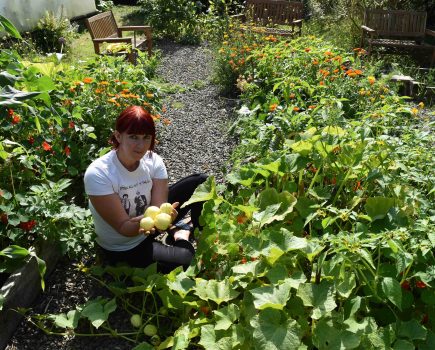Tim Tyne turns to rearing calves
Apart from applying some suitable spray to the calf’s navel and ensuring that he suckles (colostrum is critical, so do get the new born calf up and suckling as soon as possible) you need do nothing more for the first four days beyond what is dictated by common sense and good husbandry, such as keeping the cow’s udder clean, checking regularly for signs of mastitis or oedema, and generally keeping the pair under close observation for any sign of ill health or post natal complications. Let the calf enjoy the undivided attention of his mother for these few days, ensuring the best possible start in life. Now you could, of course, simply turn cow and calf out to grass at this point, and rear some good quality beef in as healthy and natural a fashion as possible. However, at a time when many commercial suckler herds are struggling to break even without production subsidies, despite economies of scale and low cost inputs, single suckling is unlikely to be economical on a small scale where input costs are often proportionately higher. Traditionally, small farms and smallholdings would have practised double- or multi-suckling, buying in additional calves to rear under each cow. We do this with some of ours and it works very well. The fact that a smallholding cow will be docile and well handled is a great help when persuading her to accept extra calves. Usually, we bring cows in to suckle the calves twice a day, but in some cases, it’s possible to turn the cow out with two, just like twins! A maternally minded, milky cow can rear a succession of calves throughout her lactation and it’s not uncommon to hear of cows that have reared four, six or even eight calves in a season. Really, though, we’re looking at keeping a house cow for domestic milk production, in which case neither single, double, or multi-suckling will be suitable. We have to harden our hearts and separate cow and calf after four days if we’re to have any of the milk for ourselves. A simple option, and the one most suited to a beginner or part-timer, is to separate the cow and calf during the day, either by turning the cow out to graze (if it’s summertime) or by having separate indoor pens (in the winter), milk the cow in the evening, then reunite the pair for the night. There are a couple of disadvantages to this system, though. First, the cow will become cunning, and, knowing that she’s about to get her calf back, she will refuse to let down any milk until she sees him. You can squeeze away at her teats all you like but she won’t give you a drop until she’s reassured herself that her baby is fine! She may take this one stage further by holding back the milk until she actually has the calf with her. This can make milking very complicated as you will constantly be having to fend off a boisterous and hungry calf. Some people claim to be able to milk one side of the cow while the calf sucks the other. Well, yes, it can be done, but having the calf slobbering and dribbling into the bucket is hardly conducive to clean milk production! The second disadvantage is that milk production is largely a matter of supply and demand. As the calf grows, and takes in more solid feed, his demand for milk will gradually tail off, so the cow will respond by producing less. This means less milk in your bucket at the end of each day, and a fairly short lactation. It’s most appropriate, if you want to get the best from your cow, to separate her from the calf completely after four days (none of ours have made a fuss about this, incidentally), milk her out twice a day in the standard fashion and rear the calf yourself. You’ll find that even after taking out what’s required for domestic consumption, there’s plenty of milk left over, so you buy in a few extra calves to rear alongside the homebred one. And when it’s time to wean these, the cow will still be churning out a fair amount of milk, so you buy in another batch of calves or some weaner pigs to slurp up the surplus, by which time, your second cow will be about due to calve, so you start all over again! Feeding Don’t feed bought in calves on the day they arrive. They will be quite stressed enough, and a bellyful of milk won’t help matters at all. Provide a bucket of fresh water with perhaps a spoonful of glucose powder added, and some clean straw to nibble at, then leave them alone in peace and quiet to get used to their new surroundings. You will need to allow one gallon of milk per calf per day, although in practice you dilute it slightly so 3 – 31/2 gallons of surplus milk will feed four calves. The rate of dilution is not an exact science, but 3:1 milk:water seems about right. Dilute at 2:1 for the first couple of feeds until the calves have settled down to the new regime. Diluted milk forms softer curds in the calf’s stomach and results in fewer occurrences of scours. If you observe a calf with a bit of a runny tummy, immediately reduce the amount of milk in the mixture to 50% or less and administer a Kaolin/Sulpha type medication (keep in stock at all times!). Don’t wait to see if it’s a bit better in the morning – it won’t be. Initially, divide the calf’s daily ration into four equal feeds, spread fairly evenly across the 24 hour period (although there’s no need to get up in the night). By the end of week one, it should be given as three feeds and after a fortnight two equal feeds of 4 pints each (3 – 31/2 pints of milk topped up with water) which will fit in nicely with the morning/evening livestock routine on the holding. To begin with, the milk should be given warm – diluting with hot water will help to offset some of the cooling that will have occurred since the milk came out of the cow – but as the calves get older, cold milk will be fine. To teach a young calf to take milk from a bucket, back him into the corner of his pen and stand astride him. Holding the bucket in one hand, dip the fingers of the other hand in the milk and insert them into the calf’s mouth (clean hands please!). He will begin to suck them, whereupon you gradually draw his head down into the bucket. The aim is to get your hand into the milk while the calf is still sucking your fingers – it will take several attempts as the calf will be used to having to look upwards for his food, not down. Hold the bucket pretty firmly or he’ll bunt it out of your hand. Most calves get the hang of it pretty quickly, so before long, there’ll be no need to restrain him, though sometimes it may be necessary to continue letting the calf suck your fingers for the first week or so. All buckets used for milk, feed and water must be kept scrupulously clean. Start offering some pelleted calf feed from the very beginning, just a little at a time, removing any uneaten and replacing twice daily. Allow one bag (25kg) of really good quality pellets per calf before changing to a standard ruminant feed. Provide a rackfull of good clean straw. Straw is preferable to hay at this stage as its fibrous nature stimulates good rumen function – the development of an efficient digestive system at an early age will stand calves in good stead for the rest of their lives. If you prefer to feed hay, because you’ve made your own, perhaps, then choose a coarser bale. Hay fed calves always seem to develop a rather pot-bellied look, though. It goes without saying that fresh water should always be available, and fresh bedding put down regularly. Dehorning and castration These are both relatively simple procedures that you can carry out yourself, after appropriate training. I learnt the necessary skills at agricultural college. You might find that LANTRA can organise tuition for a group of smallholders, or perhaps an experienced cattle keeper or your vet could give a demonstration. Calves should be dehorned using a heated dehorning iron when the horn buds are no more than 5mm high. If you have a calf crate for restraint, it simplifies things no end, otherwise you’ll need an assistant to hold them. Probably the trickiest part of the whole job is injecting the local anaesthetic at the correct point to numb the hornbuds. Whether anaesthetic should be used at all is something of a moot point – some claim quite simply that to carry out such a procedure without anaesthetic is little short of barbaric. The argument against anaesthetic is that calves seem to recover more quickly, with less bleeding, without it. The fact that they only need handling once means less stress. Get plenty of experience before forming your own opinion. A dehorning iron is quite an expensive bit of kit, and they don’t crop up second hand very often. We justify ours by carrying out dehorning for other people. Removing the horns of older cattle is not a pleasant task, and should be avoided. There are three options for castration – surgical, bloodless and rubber rings. Surgical and bloodless castration have the advantage that they can be carried out on older animals – bull calves left entire up to the age of seven months or so will develop a better conformation. Having said that, the rubber ring method (applied in the first few days) is simplicity itself. Bought-in calves may already be over the age for legal rubber ringing – avoid this problem by buying in heifer calves only. After eight weeks or so, re-house calves in group pens, with milk fed in a communal trough. Individual pens can now be dismantled, thoroughly cleaned, and rested. Weaning takes place from around 12 weeks and, assuming that your cow is still milking well, you can go out and source another batch. It’s not difficult to rear seven or more calves per cow per year like this, although four would probably be a reasonable target for the smallholder, in addition to having a good supply of milk for the house.
This article is from the September 2006 issue of Country Smallholding magazine.







